Small-sized automata (Article I): MA Dragunova, AO-46 Tkacheva, TKB-0116 Stechkina
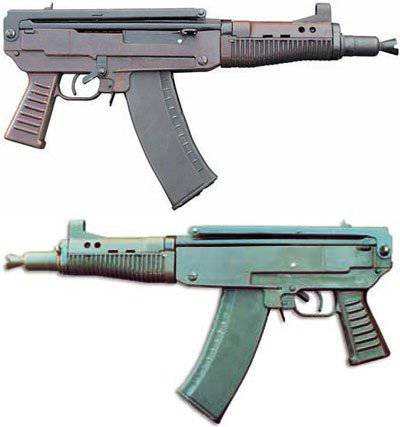 It is quite normal to ask why it was even necessary to create a small-sized machine gun when there are submachine guns. Artillery crews, armored vehicle crews, drivers, and others, for whom the machine gun primarily performs the role of self-defense weapons, will answer this question without difficulty. A pistol, as well as a submachine gun, is suitable for armament rather conditionally, since, despite its small dimensions and weight, it cannot provide relatively accurate fire even at distances up to 200 meters, not to mention ensuring individual penetration protection. Although individual munitions that appeared relatively recently, for pistols and submachine guns can be considered effective, they are clearly more expensive than the common 5,45x39. In addition, these weapons will not be superfluous in service in the protection of high-ranking officials, conducting anti-terrorist operations, and so on. At least, it will not be superfluous from the point of view of a fighter, but from the perspective of a passer-by, who can be very easily shot down from such a weapon, being at a sufficient distance from the scene, such a weapon is clearly harmful. In any case, these samples of automata are needed, and the positive and negative consequences of their use are another topic for conversation.
It is quite normal to ask why it was even necessary to create a small-sized machine gun when there are submachine guns. Artillery crews, armored vehicle crews, drivers, and others, for whom the machine gun primarily performs the role of self-defense weapons, will answer this question without difficulty. A pistol, as well as a submachine gun, is suitable for armament rather conditionally, since, despite its small dimensions and weight, it cannot provide relatively accurate fire even at distances up to 200 meters, not to mention ensuring individual penetration protection. Although individual munitions that appeared relatively recently, for pistols and submachine guns can be considered effective, they are clearly more expensive than the common 5,45x39. In addition, these weapons will not be superfluous in service in the protection of high-ranking officials, conducting anti-terrorist operations, and so on. At least, it will not be superfluous from the point of view of a fighter, but from the perspective of a passer-by, who can be very easily shot down from such a weapon, being at a sufficient distance from the scene, such a weapon is clearly harmful. In any case, these samples of automata are needed, and the positive and negative consequences of their use are another topic for conversation.You need to start with a weapon that opened an account for models of small-sized machines. To be honest, it is impossible to be a pioneer to consider the sample below, there were several models of small-sized automata, since they were all participants in the Modern contest held in the 70s of the last century. This competition was attended by the best gunsmiths of the country, many of whose surnames are no doubt familiar to everyone: Kalashnikov, Simonov, Koshkarov, Konstantinov, Stechkin and Dragunov, whose brainchild will be discussed below. In this case, the small-sized Yevgeny Fedorovich Dragunov machine gun was not chosen by chance - this weapon was actually already holding the victory in the competition held, but the desire to save and unwillingness to at least slightly rearrange the production brought victory to AKS74U. Let's try to get acquainted with what could have been instead of "Ksyusha".
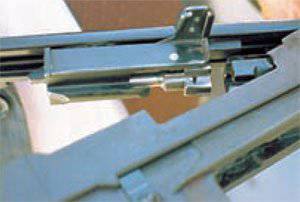 One of the interesting features of the small-sized machine gun designed by Evgeny Fedorovich Dragunov is that the name of the weapon sounds like the MA (Small-Sized Automatic Machine) Dragunov or simply MA. Designing such a weapon was not as easy as it may seem at once, the requirements that were put forward to participate in the competition were quite tough, however, it can be seen also by who took part in this competition, it is, so to speak, titans among domestic gunsmiths . The main requirements that were put forward in relation to the new weapons concerned mainly the mass and dimensions of the new models, which, in principle, is understandable, given the specifics of the weapon. Also, a separate point was the ability to fire both single shots and a burst, while the effective firing range had to reach 500 meters, which causes a sad smile. Apparently, at that time, some people took their places by a happy coincidence. New small-sized machines were limited in weight in 2,2 kilogram, and in length no more than 450 millimeters with a folded butt and no more than 750 with unfolded. Interestingly, one of the recommendations was the maximum possible use of plastic, while quite recently German Alexandrovich Korobov’s automata were rejected due to the large amount of plastic in the design, however, the weapon’s layout also played a role, and the appearance of the automata seemed to from the pages of books of science fiction, and much more, but back to the small-sized automatic machine Dragunov.
One of the interesting features of the small-sized machine gun designed by Evgeny Fedorovich Dragunov is that the name of the weapon sounds like the MA (Small-Sized Automatic Machine) Dragunov or simply MA. Designing such a weapon was not as easy as it may seem at once, the requirements that were put forward to participate in the competition were quite tough, however, it can be seen also by who took part in this competition, it is, so to speak, titans among domestic gunsmiths . The main requirements that were put forward in relation to the new weapons concerned mainly the mass and dimensions of the new models, which, in principle, is understandable, given the specifics of the weapon. Also, a separate point was the ability to fire both single shots and a burst, while the effective firing range had to reach 500 meters, which causes a sad smile. Apparently, at that time, some people took their places by a happy coincidence. New small-sized machines were limited in weight in 2,2 kilogram, and in length no more than 450 millimeters with a folded butt and no more than 750 with unfolded. Interestingly, one of the recommendations was the maximum possible use of plastic, while quite recently German Alexandrovich Korobov’s automata were rejected due to the large amount of plastic in the design, however, the weapon’s layout also played a role, and the appearance of the automata seemed to from the pages of books of science fiction, and much more, but back to the small-sized automatic machine Dragunov.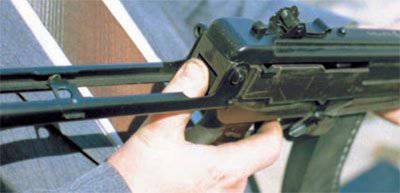 One of the main features of the MA Dragunov is that its receiver consists of two parts, fastened together with a pin, passing through the top and bottom of the receiver in front. In the upper part of the receiver, the barrel of the weapon is strengthened, as well as the bolt, the trigger mechanism of the weapon is located in the lower part, the same pin does not allow all this happiness to fall apart, the front and locking mechanism are behind, which is controlled when turning the rear sight to 90 degrees. To service the weapon, it is enough to turn the rear sight and the receiver will show everything that is hidden in it. So you can get access to all the mechanisms of weapons, while from parts that are not reinforced during maintenance, there is absolutely no one left. Thus, the maintenance of a small-sized machine can be performed even in the field, literally on the knee. It should be immediately noted that it was not possible to meet the demands that were made at the beginning of the competition, but the deviations were not so significant as to remove the weapon from the fight, especially as the design and characteristics were very good. Thus, the weight of the Dragunov compact machine is 2,5 kilogram without cartridges, its length is equal to 500 millimeters with a folded butt and 735 millimeters with unfolded, while the length of the barrel of the weapon is equal to 212 millimeters, which, of course, is not the limit.
One of the main features of the MA Dragunov is that its receiver consists of two parts, fastened together with a pin, passing through the top and bottom of the receiver in front. In the upper part of the receiver, the barrel of the weapon is strengthened, as well as the bolt, the trigger mechanism of the weapon is located in the lower part, the same pin does not allow all this happiness to fall apart, the front and locking mechanism are behind, which is controlled when turning the rear sight to 90 degrees. To service the weapon, it is enough to turn the rear sight and the receiver will show everything that is hidden in it. So you can get access to all the mechanisms of weapons, while from parts that are not reinforced during maintenance, there is absolutely no one left. Thus, the maintenance of a small-sized machine can be performed even in the field, literally on the knee. It should be immediately noted that it was not possible to meet the demands that were made at the beginning of the competition, but the deviations were not so significant as to remove the weapon from the fight, especially as the design and characteristics were very good. Thus, the weight of the Dragunov compact machine is 2,5 kilogram without cartridges, its length is equal to 500 millimeters with a folded butt and 735 millimeters with unfolded, while the length of the barrel of the weapon is equal to 212 millimeters, which, of course, is not the limit.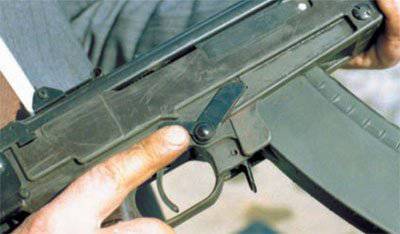 Interestingly enough in the arms, they realized the folding butt, or rather its fixation in the folded and unfolded position. This element is fixed completely independently in its extreme positions, but you can remove it from the fixing only with the help of a button that is located on the back side of the receiver of the weapon. The location of this button is such that it is very easy and conveniently pressed by the thumb, holding the weapon by the pistol grip, because all the manipulations with the butt of the weapon can be done as quickly as possible. On the right side of the Dragunov miniature submachine gun there is a fuse switch, also known as a fire interpreter. This element has two features at once. By design, this element is “G” -shaped, fixed at the bend. The small shoulder is the switch itself, the large has the purpose of blocking the shutter when the fuse is on. The lock is carried out in the simplest way, so when you move a small shoulder into a position that includes a weapon safety device, the large shoulder becomes so that it is in the way of the bolt handle. In this case, a large shoulder passes through a slot in the plastic of the receiver, which eliminates the accidental removal of the weapon from the fuse. A small shoulder when the safety is on is located so that it is level between the safety bracket and the trigger. So as soon as the weapon gets into the hands of the shooter, he understands whether it is on guard or not, which is especially important for a weapon that either shoots “once a year” or is constantly hidden around and must be ready for use at any moment. Switching fire modes of a small-sized automaton or removing it and putting it on the fuse is quite conveniently done with the right index finger, but the left hand will have to adapt to this weapon, since the controls are not duplicated on the left side.
Interestingly enough in the arms, they realized the folding butt, or rather its fixation in the folded and unfolded position. This element is fixed completely independently in its extreme positions, but you can remove it from the fixing only with the help of a button that is located on the back side of the receiver of the weapon. The location of this button is such that it is very easy and conveniently pressed by the thumb, holding the weapon by the pistol grip, because all the manipulations with the butt of the weapon can be done as quickly as possible. On the right side of the Dragunov miniature submachine gun there is a fuse switch, also known as a fire interpreter. This element has two features at once. By design, this element is “G” -shaped, fixed at the bend. The small shoulder is the switch itself, the large has the purpose of blocking the shutter when the fuse is on. The lock is carried out in the simplest way, so when you move a small shoulder into a position that includes a weapon safety device, the large shoulder becomes so that it is in the way of the bolt handle. In this case, a large shoulder passes through a slot in the plastic of the receiver, which eliminates the accidental removal of the weapon from the fuse. A small shoulder when the safety is on is located so that it is level between the safety bracket and the trigger. So as soon as the weapon gets into the hands of the shooter, he understands whether it is on guard or not, which is especially important for a weapon that either shoots “once a year” or is constantly hidden around and must be ready for use at any moment. Switching fire modes of a small-sized automaton or removing it and putting it on the fuse is quite conveniently done with the right index finger, but the left hand will have to adapt to this weapon, since the controls are not duplicated on the left side.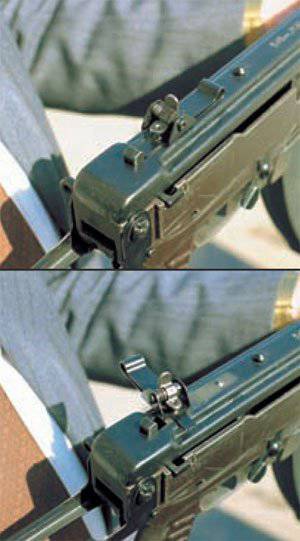 The trigger mechanism of the small-sized automatic machine gun is capable of firing both single and automatic fire. USM is made of a separate unit, which is mounted in the receiver trunnion bases of the mainspring and the axis of the trigger. In order to avoid the friction of the trigger with moving parts of the small-sized machine gun, the firing mechanism is made with a hammer blockage. In short, this feature of USM can be described as follows. A spring is a compression spring, when it is compressed, that is, when the trigger is cocked, at some point it transfers the force applied through the axis of the trigger, that is, it tends to give it the other way. When the bolt moves forward, the mainspring takes its normal place again and depending on which fire mode is set, the trigger is or does not descend. Perhaps a bit confusing, but the system itself is quite simple. Such a decision had both positive and negative qualities. Among the positive - in the first place, the great durability of parts of weapons. Negative, however, is the fact that the trigger point from the dead center was required to act on the compressed mainspring, which caused the moving mechanisms of the weapon to lose speed, and this, in turn, led to misfires, especially when the weapon was operated in not very favorable conditions and was polluted. In the end, the designer managed to create a relatively reliable weapon scheme, which achieved both high survivability and reliability. Automatic weapons built on the principle of removal of powder gases from the barrel with the barrel bore locked when turning the bolt on the 3 combat stop.
The trigger mechanism of the small-sized automatic machine gun is capable of firing both single and automatic fire. USM is made of a separate unit, which is mounted in the receiver trunnion bases of the mainspring and the axis of the trigger. In order to avoid the friction of the trigger with moving parts of the small-sized machine gun, the firing mechanism is made with a hammer blockage. In short, this feature of USM can be described as follows. A spring is a compression spring, when it is compressed, that is, when the trigger is cocked, at some point it transfers the force applied through the axis of the trigger, that is, it tends to give it the other way. When the bolt moves forward, the mainspring takes its normal place again and depending on which fire mode is set, the trigger is or does not descend. Perhaps a bit confusing, but the system itself is quite simple. Such a decision had both positive and negative qualities. Among the positive - in the first place, the great durability of parts of weapons. Negative, however, is the fact that the trigger point from the dead center was required to act on the compressed mainspring, which caused the moving mechanisms of the weapon to lose speed, and this, in turn, led to misfires, especially when the weapon was operated in not very favorable conditions and was polluted. In the end, the designer managed to create a relatively reliable weapon scheme, which achieved both high survivability and reliability. Automatic weapons built on the principle of removal of powder gases from the barrel with the barrel bore locked when turning the bolt on the 3 combat stop.An interesting point was that at least there were no complaints about the plastic parts of the weapon, but the “jumping ability” of the machine gun was noted separately. When the pistol grip fell on the concrete and when it touched it, the machine bounced, tumbling almost a meter up. What was not pleasant about this feature is difficult to say; perhaps they were afraid of the huge amount of spoiled weapons, which servicemen from idleness would throw on the ground, competing in someone above the machine gun. Not the most common weapons were sights. Instead of the usual sight and front sights, the Dragunov compact submachine gun had a diopter-changing sight designed for 300 and 500 meters, which apparently was done to fit the weapon at least into one of the requirements of the Modern contest, but we will not go into delusional demands for effective fire on 500 meters from a small-sized machine, everyone goes crazy in his own way. The machine feeds from the same stores as AK74 with a capacity of 30 cartridges.
By the time almost all the work on this weapon was completed, it was noted that in terms of accuracy of fire it was not inferior to the AKS74U, and in terms of labor intensity in production, it was completely equal to the Kalashnikov assault rifle. In addition, separately noted the small thickness of the receiver of the machine, as well as the convenience of switching fire modes. The weapon did not have elements protruding beyond its dimensions other than the bolt handle, which favorably affected wearing comfort in a wide variety of positions. However, by the time the weapon was brought to mind, they had already decided that the AKS74U would take the place of the small-sized machine, because the small-sized machine of Dragunov was abandoned into the far corner, and they gradually forgot about it. Of course, in this case, it’s difficult to put any of the characteristics of the weapon above the shortened Kalashnikov assault rifle, except that the rate of fire in automatic mode was 800 rounds per minute, but this is a rather controversial plus, provided that the same accuracy in both one and the other model . Thus, we can conclude that this machine still could claim the place of the AKS74U, although there still remained a question about the reliability of weapons in the “field conditions”, but we probably will never know these results. By the way, this small-sized machine is the last model that Yevgeny Fedorovich Dragunov completely carried out from the drawings to the already debugged model, this talented designer took only a partial part in the work on the remaining samples. So we can say that this weapon has some historical value in the weapons world.
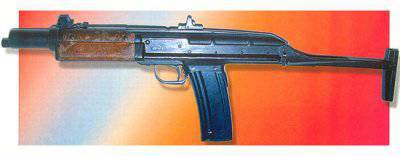 The next model of weapons, which is a representative of small-sized machines, you need to really note one of the first models of such weapons. It was created as an experimental sample, without any instructions from above, entirely on the personal initiative of Peter Andreevich Tkachev. We are talking about the machine AO-46, which was created in 1969 year, under the then only developed low-pulse cartridge 5,45x39. Perhaps many will disagree with me, and I myself am plagued by vague doubts about how fair it is to consider this machine as the first of the small-sized ones, but when comparing the size and weight with other previous models, it becomes clear that it was this weapon that was the first in which it was completely possible to realize what is required from such an automaton, namely: compactness, lightness, efficiency at medium distances. Well, the fact that a weapon may not seem quite convenient is an integral part of the board for low weight and size, but first things first.
The next model of weapons, which is a representative of small-sized machines, you need to really note one of the first models of such weapons. It was created as an experimental sample, without any instructions from above, entirely on the personal initiative of Peter Andreevich Tkachev. We are talking about the machine AO-46, which was created in 1969 year, under the then only developed low-pulse cartridge 5,45x39. Perhaps many will disagree with me, and I myself am plagued by vague doubts about how fair it is to consider this machine as the first of the small-sized ones, but when comparing the size and weight with other previous models, it becomes clear that it was this weapon that was the first in which it was completely possible to realize what is required from such an automaton, namely: compactness, lightness, efficiency at medium distances. Well, the fact that a weapon may not seem quite convenient is an integral part of the board for low weight and size, but first things first.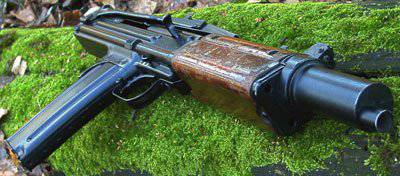 This automaton is a vivid proof that not everything is visible from above, and if you don’t stick your nose at obvious things with particular persistence, then it’s impossible to go far. So the small-sized machine gun AO-46 is nothing more than a clear desire to rectify the situation with the armament of those servicemen who do not conduct open operations with the enemy, that is, artillery crews, drivers and so on, and besides them, the crews of armored vehicles. The lack of a weapon that would be both effective and at the same time could be constantly with a fighter without interfering with his fulfillment of his main tasks was a sufficiently large hole in the armament of the army. Of course, we can say that a submachine gun can do quite well, but the effectiveness of a “pistol” ammunition does not match the effectiveness of an “automatic” cartridge at medium distances, and situations can be different, and you need to be ready for them. It was precisely this breach that the Petr Alexandrovich Tkachev decided to close with his model of a small-sized automaton.
This automaton is a vivid proof that not everything is visible from above, and if you don’t stick your nose at obvious things with particular persistence, then it’s impossible to go far. So the small-sized machine gun AO-46 is nothing more than a clear desire to rectify the situation with the armament of those servicemen who do not conduct open operations with the enemy, that is, artillery crews, drivers and so on, and besides them, the crews of armored vehicles. The lack of a weapon that would be both effective and at the same time could be constantly with a fighter without interfering with his fulfillment of his main tasks was a sufficiently large hole in the armament of the army. Of course, we can say that a submachine gun can do quite well, but the effectiveness of a “pistol” ammunition does not match the effectiveness of an “automatic” cartridge at medium distances, and situations can be different, and you need to be ready for them. It was precisely this breach that the Petr Alexandrovich Tkachev decided to close with his model of a small-sized automaton.It should be noted that the work done by the gunsmith was really very difficult, not only did there have been no attempts to create such a small machine gun, so the ammunition that was used in it was new, and examples from which it was possible Something "draw" was not. First of all, the designer carried out calculations that determined the length of the barrel of the future weapon. So, it was calculated that the speed of the bullet falls by only 145 meters per second while reducing the length of the barrel by almost two times (410 to 215 millimeters), while the speed remains quite acceptable and is equal to 735 meters per second. Actually, this was the beginning, because the length of the weapon is quite strongly influenced by the length of the barrel of a small-sized machine gun. Further - only more.
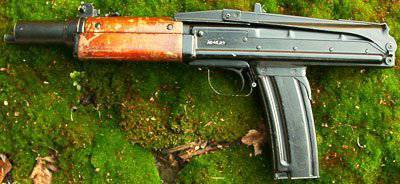 One of the problems Tkachev undertook to solve was also the length of the muzzle flame and the sound of a shot, which was loud enough. Of course, no one spoke completely about silent and flameless shooting, but at least it was quite possible to reduce these negative phenomena. The solution to these problems was quite simple. From the muzzle cut to the receiver of the weapon, holes were made in the barrel, similar to those that are made in separate models of the weapon with integrated devices for silent shooting. All this was put on a snout device, which was nothing more than a simple expansion chamber in the form of a cylinder. This made it possible to sharply reduce the pressure of the powder gases before the bullet exited the barrel, and thus reduce the sound of a shot and the length of the flame. Any flame arresters or other similar devices small-sized pistol AO-46 does not have. In addition, such a design of the weapon later allowed us to develop a silent shooting device for it and use it as a special machine, but this would be possible only if the weapon went into a series, which, as we already know, did not happen. Reducing the sound of the shot and the length of the muzzle flame allowed to use these weapons inside the premises and, which is not unimportant, it is quite comfortable to fire while inside the armored vehicles. It is noteworthy that this reduced the speed of a bullet by only 20 meters per second, and although in such matters the count goes literally by meters, it was still an acceptable indicator in order to conduct quite normal fire with normal efficiency at medium distances. However, no one planned to create long-range precision weapons. One of the features of this expansion chamber was the fact that it served as a chamber of the vapor system, and this solution was quite interesting and quite justified, since it would be very rash to additionally discharge the powder gases from the barrel bore, increase the weight of the weapon, and also would drop the speed of a bullet to ten meters, which would not be quite good.
One of the problems Tkachev undertook to solve was also the length of the muzzle flame and the sound of a shot, which was loud enough. Of course, no one spoke completely about silent and flameless shooting, but at least it was quite possible to reduce these negative phenomena. The solution to these problems was quite simple. From the muzzle cut to the receiver of the weapon, holes were made in the barrel, similar to those that are made in separate models of the weapon with integrated devices for silent shooting. All this was put on a snout device, which was nothing more than a simple expansion chamber in the form of a cylinder. This made it possible to sharply reduce the pressure of the powder gases before the bullet exited the barrel, and thus reduce the sound of a shot and the length of the flame. Any flame arresters or other similar devices small-sized pistol AO-46 does not have. In addition, such a design of the weapon later allowed us to develop a silent shooting device for it and use it as a special machine, but this would be possible only if the weapon went into a series, which, as we already know, did not happen. Reducing the sound of the shot and the length of the muzzle flame allowed to use these weapons inside the premises and, which is not unimportant, it is quite comfortable to fire while inside the armored vehicles. It is noteworthy that this reduced the speed of a bullet by only 20 meters per second, and although in such matters the count goes literally by meters, it was still an acceptable indicator in order to conduct quite normal fire with normal efficiency at medium distances. However, no one planned to create long-range precision weapons. One of the features of this expansion chamber was the fact that it served as a chamber of the vapor system, and this solution was quite interesting and quite justified, since it would be very rash to additionally discharge the powder gases from the barrel bore, increase the weight of the weapon, and also would drop the speed of a bullet to ten meters, which would not be quite good.Special attention was paid to the simplicity of the design of the weapon and its cheapness in production, while it was quite possible to sacrifice the convenience of the weapon. For this reason, it was decided to abandon the pistol grip of a small-sized machine gun; its role was performed by a detachable magazine with a capacity of 15 cartridges. Such a relatively small capacity of the store was explained by the fact that it would have been very inconvenient to hold a weapon when firing for a thick magazine; therefore, it was made single-row. In addition, in order to reduce the size of the store, for a more comfortable retention, the cartridges in it were located at a sufficiently large slope. This was supposed to negatively affect the supply of cartridges from the store, but the designer still managed to ensure that the weapon worked flawlessly, while the store was not the most convenient as a handle, but remained quite acceptable for confident holding of the machine gun. Using the store instead of the handle was not new at all; earlier in prototypes, many designers resorted to such a move as to shorten the length of the weapon. So, a bright example of this can be the machine gun of German Aleksandrovich Korobov TKB-022 No.1, however, in this weapon a single-row magazine was used for 7,62x39 cartridges, and its dimensions made it very inconvenient to hold it. So we can say that even though Tkkachev was not the designer who first used such a layout in automatic machines, he significantly improved it, significantly increasing the usability of the weapon.
 The automation of the small-sized machine gun AO-46 is based on the principle of removal of powder gases from the barrel bore, with the barrel bore being locked when the bolt is turned to two stops. Another interesting feature of the weapon is its very, very light shutter, which weighs only 70 grams. In order to ensure maximum accuracy of the weapon when shooting in automatic mode, its design uses a firing mechanism with a long stroke of the striker, its stroke is 80 millimeters, which makes the rest time in the state of rest in the forward position of the moving elements of the weapon longer. Actually, this makes shooting more heap.
The automation of the small-sized machine gun AO-46 is based on the principle of removal of powder gases from the barrel bore, with the barrel bore being locked when the bolt is turned to two stops. Another interesting feature of the weapon is its very, very light shutter, which weighs only 70 grams. In order to ensure maximum accuracy of the weapon when shooting in automatic mode, its design uses a firing mechanism with a long stroke of the striker, its stroke is 80 millimeters, which makes the rest time in the state of rest in the forward position of the moving elements of the weapon longer. Actually, this makes shooting more heap.Weapon controls are also quite well thought out in this sample small-sized machine gun. And if everything is more or less clear with the trigger and the removal of the store, then the translator of fire modes and the fuse switch can not be found immediately, but it is, just above the trigger, very convenient and quite accessible for switching with the index finger of the right hand. It represents a small lever on the right side of the weapon, which, despite its modest dimensions, is quite perceptible by touch, in general it is enough just to raise the index finger, and it falls on this control itself. Separately, it is also worth noting that it is completely protected from accidental switching, since it is closed by the protrusions on the surface of the weapon body. In order to eliminate burns in the hands of the shooter with the intensive use of weapons, the metal parts are covered with veneer plates. Aim devices are also not the simplest, but represent a dioptric overturning sight, designed for firing at a distance of 200 and 400 meters. The butt of the weapon is metal, folds up and lays down along the weapon, fixed with a special latch. It is also noteworthy that the bulk of the parts of the small-sized automaton is carried out by the method of stamping, which significantly reduces its cost in production, and also increases the speed of production.
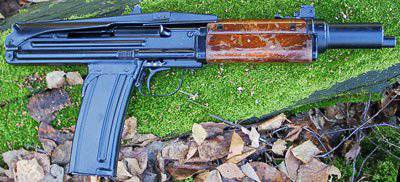 Well, now the most important thing in this weapon is its size and weight. The weight of the weapon, along with the empty magazine, which serves as a handle for holding the machine gun when shooting, is just 1,95 kilograms. The length of the machine with the folded butt is 458 millimeters, with 655 millimeters unfolded. The rate of firing in automatic shooting mode is 700 shots per minute, the effective range of weapons can reach 300 meters, which is quite enough for the tasks that are set in front of the automatic machine AO-46.
Well, now the most important thing in this weapon is its size and weight. The weight of the weapon, along with the empty magazine, which serves as a handle for holding the machine gun when shooting, is just 1,95 kilograms. The length of the machine with the folded butt is 458 millimeters, with 655 millimeters unfolded. The rate of firing in automatic shooting mode is 700 shots per minute, the effective range of weapons can reach 300 meters, which is quite enough for the tasks that are set in front of the automatic machine AO-46.It is noteworthy that this weapon, which was distinguished by its original design, passed all tests, including firing in adverse conditions (and this with such a light bolt and long stroke of the drummer), and almost got a go-ahead for mass production, but after much deliberation deprive the weapon of such honor and create competitors for it. Or rather, not even competitors, because AO-46 has already been made and tested, but to find a weapon with similar parameters, but more familiar. Actually, it was this Tkachev development machine that was the basis for the conduct of the Modern contest, and the product itself was thrown into the far corner, as the weapons were more familiar in their layout. On the other hand, maybe it was right to give other designers the opportunity to participate in the development of a new small-sized machine, for immediately grabbing the first thing that falls into the hands is clearly not the best solution, especially in the case of weapons, which should become popular.
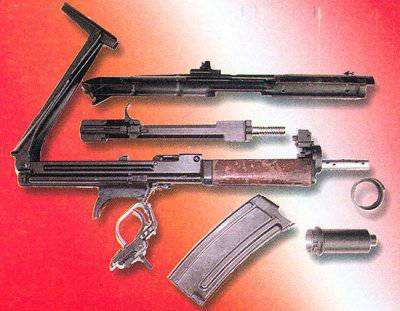 Separately, it should also be noted that in the case of the small-sized machine gun AO-46, designer Peter Aleksandrovich Tkachev, the development of weapons was indeed not in vain. Besides the fact that this machine gun pointed to a clear deficiency in the armament of the army and became the basis for holding a competition for the small-sized “Modern” machine gun, some points from this weapon served can be seen in other samples. For example, the fact that the expansion chamber, worn on the barrel, serves as a device for removal of powder gases, to ensure the operation of automation, is implemented in a fairly well-known model of weapons - a special machine gun Val. True, there the role of an expansion chamber is played by a silent-firing device, but the essence remains the essence. But such an innovation, as a store instead of a pistol grip, did not stick. In general, it is possible to say specifically about this sample that it was created for nothing, and despite the fact that it did not get into mass production, it really turned out to be very useful. And just the calculations of the behavior of the bullet cartridge 5,45x39 at different lengths of the barrel played a big role, as they accelerated the development of other models of weapons. Although, of course, everyone could do it all, but in this case the keyword “could”, but did not.
Separately, it should also be noted that in the case of the small-sized machine gun AO-46, designer Peter Aleksandrovich Tkachev, the development of weapons was indeed not in vain. Besides the fact that this machine gun pointed to a clear deficiency in the armament of the army and became the basis for holding a competition for the small-sized “Modern” machine gun, some points from this weapon served can be seen in other samples. For example, the fact that the expansion chamber, worn on the barrel, serves as a device for removal of powder gases, to ensure the operation of automation, is implemented in a fairly well-known model of weapons - a special machine gun Val. True, there the role of an expansion chamber is played by a silent-firing device, but the essence remains the essence. But such an innovation, as a store instead of a pistol grip, did not stick. In general, it is possible to say specifically about this sample that it was created for nothing, and despite the fact that it did not get into mass production, it really turned out to be very useful. And just the calculations of the behavior of the bullet cartridge 5,45x39 at different lengths of the barrel played a big role, as they accelerated the development of other models of weapons. Although, of course, everyone could do it all, but in this case the keyword “could”, but did not.But back to the weapon that was submitted to the competition "Modern". If the first machine considered in the article was different in that, in my opinion, it could well have taken the place of AKS74U, the second was the basis for the competition, then the third and last in this article small-sized machine is distinguished by its original design. So, I am pleased to present one of the most interesting samples of the competition for the small-sized “Modern” machine gun TKB-0116 developed by the well-known Igor Yakovlevich Stechkin, the same Stechkin, who developed the APS pistol, well, so that he no longer confused with anyone else). Igor Yakovlevich’s weapon really stood out against the background of other samples, but outwardly it was overlooked, but with a more detailed study of the device of the TKB-0116 small-sized submachine gun, one could be surprised at how everything was implemented in it. But let's not get ahead of ourselves, and everything in order.
 As already noted earlier, the main requirements of the competition concerned the weight and dimensions of the weapon, the possibility of automatic fire and firing single shots was also noted separately, and there was a recommendation on the use of polymers in the weapon design. Thus, the weight of the small-sized machine should not exceed 2,2 kilograms, and the length should be no more than 750 / 450 millimeters with the butt folded and folded, respectively. Nobody limited the designers in exactly how they would implement these weapon models, and absolutely any automation scheme could be used as long as the weapon fit into the requirements that became the basis for the Modern contest. Despite the seeming freedom of action, gunsmiths faced a rather difficult task and many sacrificed the mass and dimensions of weapons, exceeding the allowable limits, trying to ensure that their sample worked flawlessly in any conditions and was as accurate as possible for a small-sized machine gun. An exception was not the weapon, which was presented by Igor Yakovlevich Stechkin, his machine gun did not fit into the set frames by weight and was quite a bit longer than the one needed with the butt folded. The length of the TKB-0116 compact machine with a folded butt was 458 millimeters, but with the butt unfolded, its length was equal to 743 millimeter, that is, slightly less than the required one. The weight of the weapon exceeded the allowable limit per 110 grams and was 2,31 kilograms. And here Igor Yakovlevich went to the trick and called the weight of the weapon with a magazine with a capacity of 20 cartridges, naturally without ammunition, in the case of a magazine with a capacity of 30 cartridges, the weight increased to 2,4 kilograms. However, such tricks were superfluous, because in that competition almost all samples exceeded the set limits in weight and dimensions, which indicates how difficult the task was set for the designers, and the people who didn’t come to arms the case, and already accomplished specialists with big names. However, personally it seems to me that the requirements that were put forward were brute-force, because, in addition to the mass and dimensions of the weapon, it was necessary to ensure effective fire at a distance of up to 500 meters, which simply could not be realized with regard to the remaining requirements for the developed small-sized automatic weapons in within the competition, but back to TKB-0116.
As already noted earlier, the main requirements of the competition concerned the weight and dimensions of the weapon, the possibility of automatic fire and firing single shots was also noted separately, and there was a recommendation on the use of polymers in the weapon design. Thus, the weight of the small-sized machine should not exceed 2,2 kilograms, and the length should be no more than 750 / 450 millimeters with the butt folded and folded, respectively. Nobody limited the designers in exactly how they would implement these weapon models, and absolutely any automation scheme could be used as long as the weapon fit into the requirements that became the basis for the Modern contest. Despite the seeming freedom of action, gunsmiths faced a rather difficult task and many sacrificed the mass and dimensions of weapons, exceeding the allowable limits, trying to ensure that their sample worked flawlessly in any conditions and was as accurate as possible for a small-sized machine gun. An exception was not the weapon, which was presented by Igor Yakovlevich Stechkin, his machine gun did not fit into the set frames by weight and was quite a bit longer than the one needed with the butt folded. The length of the TKB-0116 compact machine with a folded butt was 458 millimeters, but with the butt unfolded, its length was equal to 743 millimeter, that is, slightly less than the required one. The weight of the weapon exceeded the allowable limit per 110 grams and was 2,31 kilograms. And here Igor Yakovlevich went to the trick and called the weight of the weapon with a magazine with a capacity of 20 cartridges, naturally without ammunition, in the case of a magazine with a capacity of 30 cartridges, the weight increased to 2,4 kilograms. However, such tricks were superfluous, because in that competition almost all samples exceeded the set limits in weight and dimensions, which indicates how difficult the task was set for the designers, and the people who didn’t come to arms the case, and already accomplished specialists with big names. However, personally it seems to me that the requirements that were put forward were brute-force, because, in addition to the mass and dimensions of the weapon, it was necessary to ensure effective fire at a distance of up to 500 meters, which simply could not be realized with regard to the remaining requirements for the developed small-sized automatic weapons in within the competition, but back to TKB-0116. Unlike many other gunsmiths who participated in the competition, Stechkin decided to go a longer way to develop his weapon and first made a model of the machine gun, which did not fit into any framework of the competition at all, had a great length, although a short barrel, as well as a wooden butt. . Only after this model of the weapon had been worked out the scheme of automation, the reliability was maximized and the acceptable accuracy in firing weapons was achieved, the gunsmith began working on reducing the sample so that it could fit into the framework of the competition. Igor Yakovlevich did the right thing or not, now it is difficult to judge, since the result of his work remained only in the form of weapon tests as part of the competition, but it is quite possible to understand Stechkin. The fact is that its machine is built according to a rather original scheme of automation based on the use of recoil energy with a short barrel stroke, while locking the barrel bore by turning the barrel, which is not difficult to realize in principle, but adverse conditions of use of weapons, and most importantly durability is not so simple.
Unlike many other gunsmiths who participated in the competition, Stechkin decided to go a longer way to develop his weapon and first made a model of the machine gun, which did not fit into any framework of the competition at all, had a great length, although a short barrel, as well as a wooden butt. . Only after this model of the weapon had been worked out the scheme of automation, the reliability was maximized and the acceptable accuracy in firing weapons was achieved, the gunsmith began working on reducing the sample so that it could fit into the framework of the competition. Igor Yakovlevich did the right thing or not, now it is difficult to judge, since the result of his work remained only in the form of weapon tests as part of the competition, but it is quite possible to understand Stechkin. The fact is that its machine is built according to a rather original scheme of automation based on the use of recoil energy with a short barrel stroke, while locking the barrel bore by turning the barrel, which is not difficult to realize in principle, but adverse conditions of use of weapons, and most importantly durability is not so simple.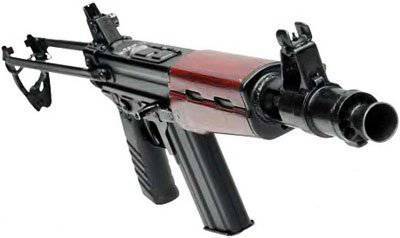 It would not be superfluous to tell you how this rather interesting system works. In its normal position, the barrel and bolt are connected to each other through the lugs that lock the barrel of the weapon. The barrel itself is made movable with the ability to turn when moving backward due to the protrusions on the barrel and the slots in the receiver of the weapon. Thus, when fired, both the bolt and the barrel begin to move backward together, with the barrel turning around its axis and coming out of its engagement with the bolt of the weapon. Through the lever, the barrel transmits its energy to the bolt, accelerating its movement, while the bolt continues to move back, extracts the cartridge case and cocks the trigger of the weapon. Having reached its extreme rear position, the bolt begins to move in the opposite direction - forward, pushes the new cartridge from the magazine, inserts it into the chamber and rests against the barrel, pushing it forward. The barrel begins to rotate back, but in the other direction and, reaching its extreme rear position, enters a reliable grip with the bolt, and then the system freezes in a single fire mode or a new shot occurs and everything repeats again. To ensure the normal operation of the automation system, the designer had to pay a lot of attention to ensuring that the speed of movement of the barrel was high enough, therefore, for this purpose, a retarding device was developed, which is both a flame arrester and an accelerator of the barrel - vice versa, so to speak. Another interesting point is also the fact that the release of spent cartridges is not made from the side, but on top of the weapon, the window itself is covered with a shutter, which automatically comes off when the bolt moves back. It is immediately clear that such an automation system has its positive qualities in the form of softer recoil when firing, which is especially important for a compact model of weapons, and its shortcomings, which are much more than it might seem at first glance. First of all, many questions are caused by the reliability of the implementation of the rotation of the barrel. At the same time, in principle, in terms of reliability, more or less acceptable results can be achieved, but the fact that the wear of the weapon will affect both the barrel and the receiver is a clear disadvantage, even for weapons that should fire infrequently. The second negative point is the susceptibility of such a system to various contaminants, and most importantly - to fine sand, which, if it does not jam the automation (the mass of moving parts is large enough), it is guaranteed to increase its wear. Well, the most important thing is the price during production, since the implementation of such a system will be rather difficult, and there will be a lot of waste in the production process.
It would not be superfluous to tell you how this rather interesting system works. In its normal position, the barrel and bolt are connected to each other through the lugs that lock the barrel of the weapon. The barrel itself is made movable with the ability to turn when moving backward due to the protrusions on the barrel and the slots in the receiver of the weapon. Thus, when fired, both the bolt and the barrel begin to move backward together, with the barrel turning around its axis and coming out of its engagement with the bolt of the weapon. Through the lever, the barrel transmits its energy to the bolt, accelerating its movement, while the bolt continues to move back, extracts the cartridge case and cocks the trigger of the weapon. Having reached its extreme rear position, the bolt begins to move in the opposite direction - forward, pushes the new cartridge from the magazine, inserts it into the chamber and rests against the barrel, pushing it forward. The barrel begins to rotate back, but in the other direction and, reaching its extreme rear position, enters a reliable grip with the bolt, and then the system freezes in a single fire mode or a new shot occurs and everything repeats again. To ensure the normal operation of the automation system, the designer had to pay a lot of attention to ensuring that the speed of movement of the barrel was high enough, therefore, for this purpose, a retarding device was developed, which is both a flame arrester and an accelerator of the barrel - vice versa, so to speak. Another interesting point is also the fact that the release of spent cartridges is not made from the side, but on top of the weapon, the window itself is covered with a shutter, which automatically comes off when the bolt moves back. It is immediately clear that such an automation system has its positive qualities in the form of softer recoil when firing, which is especially important for a compact model of weapons, and its shortcomings, which are much more than it might seem at first glance. First of all, many questions are caused by the reliability of the implementation of the rotation of the barrel. At the same time, in principle, in terms of reliability, more or less acceptable results can be achieved, but the fact that the wear of the weapon will affect both the barrel and the receiver is a clear disadvantage, even for weapons that should fire infrequently. The second negative point is the susceptibility of such a system to various contaminants, and most importantly - to fine sand, which, if it does not jam the automation (the mass of moving parts is large enough), it is guaranteed to increase its wear. Well, the most important thing is the price during production, since the implementation of such a system will be rather difficult, and there will be a lot of waste in the production process.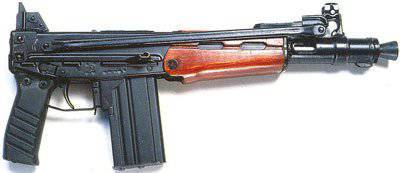
It feeds on Stechkin’s small-sized machine gun from detachable box magazines, while it’s remarkable that a separate store of direct construction with a capacity of 20 cartridges was created for weapons; lost the ability to use shops from a Kalashnikov assault rifle with a capacity of 30 cartridges. The butt of the TKB-0116 small-sized machine is folded up, has a folding support for the shoulder, is fixed with a latch on the base of the front sight. Sights are represented by open devices in the form of a rear sight and a front sight, the rear sight has adjustment with marks 100, 400, 500 meters, well, well, and the position of a direct shot. In a slightly angular and rather large pistol grip of a small-sized machine gun there are means for servicing the weapon, which put this sample one step higher than the others. The switch fuse and fire modes in the machine is located above
Trigger, with a small removal in the direction of the handle of the weapon, which can be inconvenient for people with large sizes of palms. Given that the effort to retract the bolt to the rearmost position is large enough, it is not surprising that the bolt handle is large and strongly protrudes from the right side of the weapon, which can adversely affect the wearing of the weapon on the left shoulder.
The TKB-0116 small-sized pistol reached the final of the Modern contest; in it, he met his main rival PP-1, which later became better known as AKS74U, after winning and adopting weapons. When comparing these two samples, the advantage of the small-sized Stechkin submachine gun was noted in terms of the following parameters: a lower sound pressure level when fired on the shooter; less weight and shorter arms with a folded butt; less influence of the work of mechanisms on the accuracy of firing. However, all these advantages were rather conditional and did not make any of TKB-0116 items much better than AKS74U. What is surprising is that when comparing both samples, it was noted that both of them equally well tolerate various contaminants and work flawlessly in conditions that are not the most favorable for firearms, and this is despite the fact that Stechkin’s sample should have lost to Kalashnikov articles because of its automation. However, there were other equally interesting types of weapons that could easily compete in reliability, and accuracy, and other characteristics with Kalashnikov and Stechkin. Well, the result of this competition of the most talented gunsmiths is known to us. Despite the rather large number of weapon models that were better than Ksyusha in one way or another, none of them could compete with weapons that had already been mastered in production, or rather its full-fledged model, and to adapt production to a shorter model it is a lot of work, and the cost is minimal. So Kalashnikov and in this competition came out the winner, as, indeed, in many others. On the one hand, I do not diminish Mikhail Timofeevich’s merits in the development of Russian weapons business, but sometimes I want so much to see what we would have, if somewhere Kalashnikov gave way to other gunsmiths. And it’s completely incomprehensible to me why many of the really promising models of weapons were simply simply abandoned and forgotten, when they could be gradually brought to mind and in small quantities, even if they could be supplied in the army as an experiment, and suddenly something really worthy was born and better than AK, as a result of the parallel development of other samples. Here is the same automatic machine Igor Yakovlevich Stechkin more than an interesting model, worthy of attention and further development.
On this I think it is necessary to finish the first article from the series of materials about small-sized machines. Ahead there are a lot of “tasty” and interesting, including weapon models that were already after the end of the “Modern” competition, already under completely different ammunition. But I will not disclose all interests, I will keep a little intrigue. Strangely enough, but what Tkachev once showed with his machine gun AO-46 really turned out to be a very important gap in the country's armament, and decided to take up this issue quite thoroughly. However, the last of the models of small-sized automata have already been created for several other purposes and with other required basic parameters, but more on this in other articles.
Information